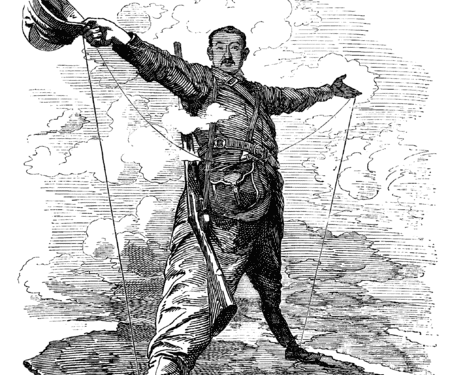 | ||
The rhodes colossus
The Rhodes Colossus is an iconic editorial cartoon of the Scramble for Africa period, part of the New Imperialism, depicting British colonialist Cecil Rhodes as a giant standing over the continent.
Contents
The cartoon was drawn by Edward Linley Sambourne, and first appeared in Punch magazine in 1892. It was widely reprinted in its time, and has since become a standard illustration in history texts.
The cartoon was published in the 10 December 1892 edition of Punch, appearing beside a recent excerpt from The Times about a Rhodes plan to extend an electrical telegraph line from Cape Town to Cairo.
It was led by a piece of satirical verse on the character and ambitions of Rhodes:
Iconography and influence
Rhodes is shown in a visual pun as the ancient Greek statue the Colossus of Rhodes, following the traditional (and architecturally unlikely) depiction of the Colossus with wide-set legs across Rhodes harbour (above).
Rhodes measures with the telegraphic line the distance from Cape Town (at his right foot) in South Africa to Cairo (at his left foot) in Egypt, illustrating his broader "Cape to Cairo" concept for British domination of Africa.
The cartoon is recognised today as a standard illustration in history texts of the Scramble for Africa, and of Colonialism as a whole. The original context of a proposed telegraph line is rarely mentioned in such reproductions, which take the "Cape to Cairo" concept more generally.
In 2009, the South African cartoonist Jonathan Shapiro parodied the famous cartoon by placing Chinese premier Wen Jiabao in place of Rhodes holding up Nkosazana Dlamini-Zuma, the then Minister of Foreign Affairs, like a marionette, while the Dalai Lama looks on from Asia. The cartoon satirised Sino-African relations in general, and recent China-South Africa relations in particular, after the Dalai Lama was denied a visa to attend an international peace conference in Johannesburg, a move that was perceived to be the result of Chinese pressure.
The Rhodes cartoon also influenced political cartoonist Martin Rowson, who published on 1 February 2013 a drawing in The Guardian on British prime minister David Cameron's policy regarding Algeria and the French intervention in Mali.
